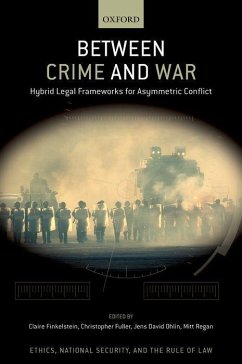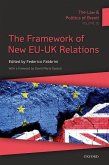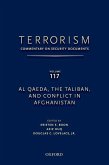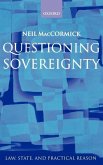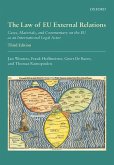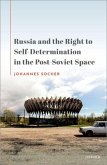Between Crime and War
Hybrid Legal Frameworks for Asymmetric Conflict
Herausgeber: Ohlin, Jens David; Regan, Mitt; Fuller, Christopher J; Finkelstein, Claire
Between Crime and War
Hybrid Legal Frameworks for Asymmetric Conflict
Herausgeber: Ohlin, Jens David; Regan, Mitt; Fuller, Christopher J; Finkelstein, Claire
- Gebundenes Buch
- Merkliste
- Auf die Merkliste
- Bewerten Bewerten
- Teilen
- Produkt teilen
- Produkterinnerung
- Produkterinnerung
The threat posed by the recent rise of transnational non-state armed groups does not fit easily within either of the two basic paradigms for state responses to violence. The civilian paradigm focuses on the interception of demonstrable immediate threats to the safety of others. The military paradigm focuses on threats posed by collective actors who pose a danger to the state's ability to maintain basic social order and, at times, the state. The book suggests, that we need not see the options as confined to this binary choice as it evaluates the philosophical and ethical implications of using…mehr
Andere Kunden interessierten sich auch für
![The Law and Politics of Brexit: Volume III The Law and Politics of Brexit: Volume III]() The Law and Politics of Brexit: Volume III144,99 €
The Law and Politics of Brexit: Volume III144,99 €![Terrorism: Commentary on Security Documents Volume 117 Terrorism: Commentary on Security Documents Volume 117]() Douglas LovelaceTerrorism: Commentary on Security Documents Volume 117204,99 €
Douglas LovelaceTerrorism: Commentary on Security Documents Volume 117204,99 €![Questioning Sovereignty Questioning Sovereignty]() Neil MaccormickQuestioning Sovereignty186,99 €
Neil MaccormickQuestioning Sovereignty186,99 €![Foreign Relations Federalism Foreign Relations Federalism]() Thomas VerellenForeign Relations Federalism137,99 €
Thomas VerellenForeign Relations Federalism137,99 €![Regulating Health and Environmental Risks Under Wto Law Regulating Health and Environmental Risks Under Wto Law]() Lukasz GruszczynskiRegulating Health and Environmental Risks Under Wto Law153,99 €
Lukasz GruszczynskiRegulating Health and Environmental Risks Under Wto Law153,99 €![Law of Eu External Relations Law of Eu External Relations]() Jan WoutersLaw of Eu External Relations236,99 €
Jan WoutersLaw of Eu External Relations236,99 €![Russia and the Right to Self-Determination in the Post-Soviet Space Russia and the Right to Self-Determination in the Post-Soviet Space]() Johannes SocherRussia and the Right to Self-Determination in the Post-Soviet Space141,99 €
Johannes SocherRussia and the Right to Self-Determination in the Post-Soviet Space141,99 €-
-
-
The threat posed by the recent rise of transnational non-state armed groups does not fit easily within either of the two basic paradigms for state responses to violence. The civilian paradigm focuses on the interception of demonstrable immediate threats to the safety of others. The military paradigm focuses on threats posed by collective actors who pose a danger to the state's ability to maintain basic social order and, at times, the state. The book suggests, that we need not see the options as confined to this binary choice as it evaluates the philosophical and ethical implications of using both military and non-military frameworks for pursuing counterterrorism operations.
Hinweis: Dieser Artikel kann nur an eine deutsche Lieferadresse ausgeliefert werden.
Hinweis: Dieser Artikel kann nur an eine deutsche Lieferadresse ausgeliefert werden.
Produktdetails
- Produktdetails
- Verlag: Hurst & Co.
- Seitenzahl: 592
- Erscheinungstermin: 11. Dezember 2022
- Englisch
- Abmessung: 241mm x 160mm x 41mm
- Gewicht: 960g
- ISBN-13: 9780197638798
- ISBN-10: 0197638791
- Artikelnr.: 66113100
- Herstellerkennzeichnung
- Libri GmbH
- Europaallee 1
- 36244 Bad Hersfeld
- gpsr@libri.de
- Verlag: Hurst & Co.
- Seitenzahl: 592
- Erscheinungstermin: 11. Dezember 2022
- Englisch
- Abmessung: 241mm x 160mm x 41mm
- Gewicht: 960g
- ISBN-13: 9780197638798
- ISBN-10: 0197638791
- Artikelnr.: 66113100
- Herstellerkennzeichnung
- Libri GmbH
- Europaallee 1
- 36244 Bad Hersfeld
- gpsr@libri.de
Claire Finkelstein is the Algernon Biddle Professor of Law and Professor of Philosophy at the University of Pennsylvania. Claire Finkelstein's current research addresses national security law and policy and democratic governance with a focus on related ethical and rule of law issues. Professor Finkelstein is the founder and faculty director of the Center for Ethics and the Rule of Law (CERL), a non-partisan interdisciplinary institute affiliated with the University of Pennsylvania's Annenberg Public Policy Center (APPC). Christopher J. Fuller is Associate Professor of Modern U.S. Foreign Policy and Head of Admissions at the University of Southampton. He specializes in U.S. foreign policy from 1945 to the present day with a particular interest in the "War on Terror" and wider U.S. counterterrorism practices. His previous books include See It/Shoot It: The Secret History of the CIA's Lethal Drone Program (2017). Jens David Ohlin became the Allan R. Tessler Dean of Cornell Law School on July 1, 2021. His scholarly work stands at the intersection of four related fields: criminal law, criminal procedure, public international law, and the laws of war. Trained as both a lawyer and a philosopher, his research has tackled questions as diverse as criminal conspiracy and the punishment of collective criminal action, the philosophical foundations of international law, and the role of new technologies in warfare, including cyberwar, remotely piloted drones, and autonomous weapons. Mitt Regan is McDevitt Professor of Jurisprudence, Director of the Center on the Legal Profession, and Co-Director on the Center on National Security and the Law at Georgetown University Law Center. His work focuses on international law, national security, international human rights, and legal and military ethics. Professor Regan is also Senior Fellow at the Stockdale Center for Ethical Leadership at the U.S. Naval Academy, and Adjunct Faculty Member at the Center for Military and Security Law at the Australian National University College of Law.
* Forward
* Lieutenant General Charles N. Pede
* Introduction
* Jens David Ohlin and Mitt Regan
* Part I: The Framework Problem in Modern Conflict: Can we Still
Distinguish War From Crime?
* Chapter 1. Non-State Actors, Terrorism, and the War Paradigm
Revisited
* Seth Cantey
* Chapter 2. The Limits of Law and the Value of Rights in Addressing
Terrorism: A Study of the UN Counter-Terrorism Architecture
* Fionnuala Ní Aoláin
* Chapter 3. The Paradox of Discrimination: When More Violence Triggers
Fewer Legal Constraints
* Jens David Ohlin
* Chapter 4. Fighting Terrorism under All Applicable Law
* Joshua Andresen
* Chapter 5. When Conflict Recurs: Classification of Conflict when
Hostilities Break Out Anew
* Laurie Blank
* Part II: War as Criminal Enforcement
* Chapter 6. Non-State Actors in a Post-War World: Conceptualizing War
as Criminal Enforcement
* Claire Finkelstein
* Chapter 7. Urban Warfare: Policing Conflict
* Ken Watkin
* Chapter 8. Ratchet Down or Ramp Up? Contemporary Threats, Armed
Conflict, and Tailored Authority
* Geoff Corn
* Chapter 9. Using Law as a Weapon Against Nuclear Proliferation and
Terrorism: The U.S. Government's Financial Lawfare Against Iran
* Orde F. Kittrie
* Chapter 10. Human Rights Law as an Alternative to Jus in Bello
* Christopher J. Fuller
* Part III: Fighting Crime as War
* Chapter 11. National Security Policymaking in the Shadow of
International Law
* Laura Dickinson
* Chapter 12. Emerging Transnational Self-Defense Norms and Unrealized
Liberal Values
* John Dehn
* Chapter 13. Finding Peace in the Law of War
* Lieutenant Colonel Bailey Brown
* Chapter 14. From Armed Conflict to Countering Threat Networks:
Counterterrorism and Social Network Analysis
* Todd Huntley and Mitt Regan
* Part IV: crime and war: prosecuting terrorism and war crimes
* Chapter 15. Counting the Ripples: The Challenge of Extraterritorial
Jurisdiction to Prosecute Non-State Actors
* Evan R. Seamone
* Chapter 16. Diversifying the Sources of Evidence in Terrorism Cases
Before Criminal Courts in (Post-)Conflict and High-Risk Situations:
The Role of The Military
* Bibi Van Ginkel, Christophe Paulussen, and Tanya Mehra
* Chapter 17. U.S. Military Prosecutions During Non-International Armed
Conflict
* Chris Jenks
* Lieutenant General Charles N. Pede
* Introduction
* Jens David Ohlin and Mitt Regan
* Part I: The Framework Problem in Modern Conflict: Can we Still
Distinguish War From Crime?
* Chapter 1. Non-State Actors, Terrorism, and the War Paradigm
Revisited
* Seth Cantey
* Chapter 2. The Limits of Law and the Value of Rights in Addressing
Terrorism: A Study of the UN Counter-Terrorism Architecture
* Fionnuala Ní Aoláin
* Chapter 3. The Paradox of Discrimination: When More Violence Triggers
Fewer Legal Constraints
* Jens David Ohlin
* Chapter 4. Fighting Terrorism under All Applicable Law
* Joshua Andresen
* Chapter 5. When Conflict Recurs: Classification of Conflict when
Hostilities Break Out Anew
* Laurie Blank
* Part II: War as Criminal Enforcement
* Chapter 6. Non-State Actors in a Post-War World: Conceptualizing War
as Criminal Enforcement
* Claire Finkelstein
* Chapter 7. Urban Warfare: Policing Conflict
* Ken Watkin
* Chapter 8. Ratchet Down or Ramp Up? Contemporary Threats, Armed
Conflict, and Tailored Authority
* Geoff Corn
* Chapter 9. Using Law as a Weapon Against Nuclear Proliferation and
Terrorism: The U.S. Government's Financial Lawfare Against Iran
* Orde F. Kittrie
* Chapter 10. Human Rights Law as an Alternative to Jus in Bello
* Christopher J. Fuller
* Part III: Fighting Crime as War
* Chapter 11. National Security Policymaking in the Shadow of
International Law
* Laura Dickinson
* Chapter 12. Emerging Transnational Self-Defense Norms and Unrealized
Liberal Values
* John Dehn
* Chapter 13. Finding Peace in the Law of War
* Lieutenant Colonel Bailey Brown
* Chapter 14. From Armed Conflict to Countering Threat Networks:
Counterterrorism and Social Network Analysis
* Todd Huntley and Mitt Regan
* Part IV: crime and war: prosecuting terrorism and war crimes
* Chapter 15. Counting the Ripples: The Challenge of Extraterritorial
Jurisdiction to Prosecute Non-State Actors
* Evan R. Seamone
* Chapter 16. Diversifying the Sources of Evidence in Terrorism Cases
Before Criminal Courts in (Post-)Conflict and High-Risk Situations:
The Role of The Military
* Bibi Van Ginkel, Christophe Paulussen, and Tanya Mehra
* Chapter 17. U.S. Military Prosecutions During Non-International Armed
Conflict
* Chris Jenks
* Forward
* Lieutenant General Charles N. Pede
* Introduction
* Jens David Ohlin and Mitt Regan
* Part I: The Framework Problem in Modern Conflict: Can we Still
Distinguish War From Crime?
* Chapter 1. Non-State Actors, Terrorism, and the War Paradigm
Revisited
* Seth Cantey
* Chapter 2. The Limits of Law and the Value of Rights in Addressing
Terrorism: A Study of the UN Counter-Terrorism Architecture
* Fionnuala Ní Aoláin
* Chapter 3. The Paradox of Discrimination: When More Violence Triggers
Fewer Legal Constraints
* Jens David Ohlin
* Chapter 4. Fighting Terrorism under All Applicable Law
* Joshua Andresen
* Chapter 5. When Conflict Recurs: Classification of Conflict when
Hostilities Break Out Anew
* Laurie Blank
* Part II: War as Criminal Enforcement
* Chapter 6. Non-State Actors in a Post-War World: Conceptualizing War
as Criminal Enforcement
* Claire Finkelstein
* Chapter 7. Urban Warfare: Policing Conflict
* Ken Watkin
* Chapter 8. Ratchet Down or Ramp Up? Contemporary Threats, Armed
Conflict, and Tailored Authority
* Geoff Corn
* Chapter 9. Using Law as a Weapon Against Nuclear Proliferation and
Terrorism: The U.S. Government's Financial Lawfare Against Iran
* Orde F. Kittrie
* Chapter 10. Human Rights Law as an Alternative to Jus in Bello
* Christopher J. Fuller
* Part III: Fighting Crime as War
* Chapter 11. National Security Policymaking in the Shadow of
International Law
* Laura Dickinson
* Chapter 12. Emerging Transnational Self-Defense Norms and Unrealized
Liberal Values
* John Dehn
* Chapter 13. Finding Peace in the Law of War
* Lieutenant Colonel Bailey Brown
* Chapter 14. From Armed Conflict to Countering Threat Networks:
Counterterrorism and Social Network Analysis
* Todd Huntley and Mitt Regan
* Part IV: crime and war: prosecuting terrorism and war crimes
* Chapter 15. Counting the Ripples: The Challenge of Extraterritorial
Jurisdiction to Prosecute Non-State Actors
* Evan R. Seamone
* Chapter 16. Diversifying the Sources of Evidence in Terrorism Cases
Before Criminal Courts in (Post-)Conflict and High-Risk Situations:
The Role of The Military
* Bibi Van Ginkel, Christophe Paulussen, and Tanya Mehra
* Chapter 17. U.S. Military Prosecutions During Non-International Armed
Conflict
* Chris Jenks
* Lieutenant General Charles N. Pede
* Introduction
* Jens David Ohlin and Mitt Regan
* Part I: The Framework Problem in Modern Conflict: Can we Still
Distinguish War From Crime?
* Chapter 1. Non-State Actors, Terrorism, and the War Paradigm
Revisited
* Seth Cantey
* Chapter 2. The Limits of Law and the Value of Rights in Addressing
Terrorism: A Study of the UN Counter-Terrorism Architecture
* Fionnuala Ní Aoláin
* Chapter 3. The Paradox of Discrimination: When More Violence Triggers
Fewer Legal Constraints
* Jens David Ohlin
* Chapter 4. Fighting Terrorism under All Applicable Law
* Joshua Andresen
* Chapter 5. When Conflict Recurs: Classification of Conflict when
Hostilities Break Out Anew
* Laurie Blank
* Part II: War as Criminal Enforcement
* Chapter 6. Non-State Actors in a Post-War World: Conceptualizing War
as Criminal Enforcement
* Claire Finkelstein
* Chapter 7. Urban Warfare: Policing Conflict
* Ken Watkin
* Chapter 8. Ratchet Down or Ramp Up? Contemporary Threats, Armed
Conflict, and Tailored Authority
* Geoff Corn
* Chapter 9. Using Law as a Weapon Against Nuclear Proliferation and
Terrorism: The U.S. Government's Financial Lawfare Against Iran
* Orde F. Kittrie
* Chapter 10. Human Rights Law as an Alternative to Jus in Bello
* Christopher J. Fuller
* Part III: Fighting Crime as War
* Chapter 11. National Security Policymaking in the Shadow of
International Law
* Laura Dickinson
* Chapter 12. Emerging Transnational Self-Defense Norms and Unrealized
Liberal Values
* John Dehn
* Chapter 13. Finding Peace in the Law of War
* Lieutenant Colonel Bailey Brown
* Chapter 14. From Armed Conflict to Countering Threat Networks:
Counterterrorism and Social Network Analysis
* Todd Huntley and Mitt Regan
* Part IV: crime and war: prosecuting terrorism and war crimes
* Chapter 15. Counting the Ripples: The Challenge of Extraterritorial
Jurisdiction to Prosecute Non-State Actors
* Evan R. Seamone
* Chapter 16. Diversifying the Sources of Evidence in Terrorism Cases
Before Criminal Courts in (Post-)Conflict and High-Risk Situations:
The Role of The Military
* Bibi Van Ginkel, Christophe Paulussen, and Tanya Mehra
* Chapter 17. U.S. Military Prosecutions During Non-International Armed
Conflict
* Chris Jenks

